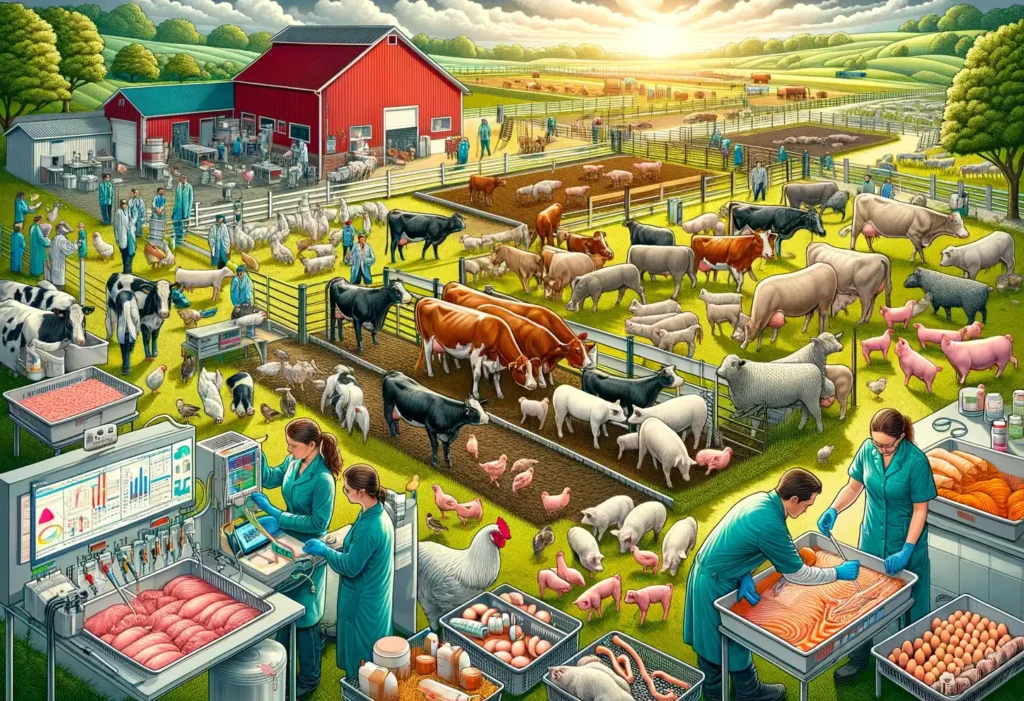
Reproduction Management A detailed and informative illustration depicting farm reproduction management. The scene includes a variety of farm animals such as cows pigs and c 2.webp.webp
Definition: Reproduction Management
Overview
Reproduction management refers to the systematic and strategic planning, monitoring, and controlling of breeding practices to improve the reproductive performance of livestock. This includes techniques and practices aimed at enhancing fertility, optimizing breeding schedules, managing genetic quality, and ensuring the health and productivity of both male and female breeding animals. Effective reproduction management is crucial for maximizing the productivity and profitability of agricultural operations.
Benefits of Reproduction Management
Improved Fertility Rates
Effective reproduction management practices lead to higher fertility rates among livestock. By monitoring and managing the reproductive health of animals, farmers can increase the likelihood of successful pregnancies and reduce the interval between births.
Fall off the barn roof and busted your keister? Life on the farm or ranch can be tough on the bum. Need a break? Laugh it off at FarmerCowboy.com, the #1 farm humor site. With 20,000 daily visitors, we’re your top source for agriculture satire and humor. Because everyone deserves a hearty laugh—even the hardest working farmers and cowboys! Join us and turn those long days into fun tales at FarmerCowboy.com.
Enhanced Genetic Quality
By carefully selecting breeding pairs based on genetic traits, reproduction management helps improve the genetic quality of livestock. This can result in healthier, more productive animals with desirable characteristics such as disease resistance, growth rate, and milk production.
Increased Productivity
Optimizing reproductive schedules and ensuring the health of breeding animals contribute to increased productivity. Effective management practices lead to more offspring per breeding cycle, better growth rates, and higher overall output from the herd or flock.
Components of Reproduction Management
Breeding Plans
Developing a comprehensive breeding plan is a fundamental aspect of reproduction management. This plan should outline the goals, strategies, and timelines for breeding activities, taking into account factors such as genetic selection, breeding seasons, and production targets.
Health Monitoring
Regular health monitoring of breeding animals is essential for successful reproduction. This includes routine veterinary check-ups, vaccinations, and health screenings to detect and address any issues that could affect reproductive performance.
Nutrition
Proper nutrition plays a critical role in reproductive health. Providing balanced diets that meet the specific needs of breeding animals helps ensure they are in optimal condition for successful breeding. This includes adequate intake of vitamins, minerals, and energy.
Techniques in Reproduction Management
Artificial Insemination (AI)
Artificial insemination (AI) is a widely used technique in reproduction management. It involves the collection and direct insertion of semen into the reproductive tract of a female animal. AI allows for precise control over breeding and the use of high-quality genetics from distant or superior sires.
Estrus Synchronization
Estrus synchronization involves the manipulation of the estrous cycle of female animals so that they come into heat simultaneously. This technique facilitates timed breeding and artificial insemination, leading to more efficient management of the breeding process.
Embryo Transfer
Embryo transfer is an advanced technique where embryos from a genetically superior donor female are transferred to recipient females. This allows for rapid genetic improvement and the production of multiple offspring from high-quality animals in a single breeding season.
Best Practices for Reproduction Management
Record Keeping
Maintaining detailed records of breeding activities, health status, and genetic information is crucial for effective reproduction management. These records help farmers make informed decisions, track progress, and identify areas for improvement.
Regular Training
Providing regular training for farm staff on reproduction management practices ensures that everyone involved is knowledgeable and skilled in the latest techniques and technologies. This can lead to more successful breeding outcomes and improved overall productivity.
Biosecurity Measures
Implementing strict biosecurity measures helps prevent the spread of diseases that can negatively impact reproductive performance. This includes controlling access to breeding facilities, practicing good hygiene, and monitoring for signs of illness.
Economic Considerations
Cost of Technologies
The adoption of advanced reproduction management technologies, such as AI and embryo transfer, can involve significant initial costs. However, these technologies often lead to long-term economic benefits through improved productivity and genetic quality.
Return on Investment
Conducting a cost-benefit analysis can help farmers assess the return on investment of different reproduction management practices. This analysis should consider factors such as increased fertility rates, improved genetic traits, and higher productivity.
Environmental Impact
Sustainable Practices
Implementing sustainable reproduction management practices can have positive environmental impacts. For example, improving the genetic quality of livestock can lead to more efficient feed conversion and reduced waste, contributing to a more sustainable agricultural system.
Resource Management
Effective reproduction management helps optimize the use of resources such as feed, water, and land. By improving reproductive efficiency, farmers can produce more with fewer resources, reducing the environmental footprint of their operations.
Case Studies
Case Study 1: Increased Dairy Production
A dairy farm in Wisconsin implemented a comprehensive reproduction management program, including AI and estrus synchronization. As a result, the farm saw a 25% increase in milk production per cow and a significant reduction in the calving interval.
Case Study 2: Genetic Improvement in Beef Cattle
A beef cattle operation in Texas utilized embryo transfer and selective breeding to enhance the genetic quality of their herd. Over five years, the farm achieved notable improvements in growth rates, feed efficiency, and overall herd health, leading to higher profitability.
Conclusion
Reproduction management is a critical component of successful livestock farming. By implementing strategic breeding plans, monitoring animal health, and adopting advanced reproductive technologies, farmers can improve fertility rates, enhance genetic quality, and increase overall productivity. Effective reproduction management not only benefits individual farming operations but also contributes to the sustainability and efficiency of the agricultural sector as a whole.

Originally posted 2021-04-16 00:57:51.
Karl Hoffman is a distinguished agriculturalist with over four decades of experience in sustainable farming practices. He holds a Ph.D. in Agronomy from Cornell University and has made significant contributions as a professor at Iowa State University. Hoffman’s groundbreaking research on integrated pest management and soil health has revolutionized modern agriculture. As a respected farm journalist, his column “Field Notes with Karl Hoffman” and his blog “The Modern Farmer” provide insightful, practical advice to a global audience. Hoffman’s work with the USDA and the United Nations FAO has enhanced food security worldwide. His awards include the USDA’s Distinguished Service Award and the World Food Prize, reflecting his profound impact on agriculture and sustainability.




